I haven't provided detailed commentary on the US labour market for a while now. To…
Australian Labour Force – unemployment and underemployment rises and the Government celebrates
On a day that the Federal government was telling Australians that it was time to celebrate as a result of the fiscal situation achieving balance, the unemployment and underemployment rates rose. This is neoliberalism – August 2019 style. The Australian Bureau of Statistics released the latest data today – Labour Force, Australia, August 2019 – which reveals a fairly weak labour market with where employment growth is not strong enough to absorb the increasing labour force as participation continues to creep up. As a result, unemployment rose again, albeit modestly. The disturbing trend in this rather weak environment is that underemployment rose by 0.2 points) to 8.6 per cent further and the total labour underutilisation rate (unemployment plus underemployment) rose as a consequence to 13.7 per cent. In the last two months, underemployment has risen by 0.4 points. Both the unemployment and underemployment rates are persisting around these elevated levels of wastage making a mockery of claims by commentators that Australia is close to full employment and that the fiscal position represents something desirable. The unemployment rate is 7 percentage points above what even the central bank considers to the level where inflationary pressures might be sourced from the labour market. This persistence in labour wastage indicates that the policy settings are to tight (biased to austerity) and deliberately reducing growth and income generation. My overall assessment is the current situation can best be characterised as remaining in a fairly weak state.
The summary ABS Labour Force (seasonally adjusted) estimates for August 2019 are:
- Employment increased by 34,700 (0.2 per cent) – Full-time employment decreased by 15,500 and part-time employment increased by 50,200.
- Unemployment increased by 4,100 to 716,800 persons.
- The official unemployment rate rose to 5.3 per cent.
- The participation rate increased by 0.1 points to 66.2 per cent.
- Aggregate monthly hours worked increased by 3.9 million hours (0.2 per cent).
- Underemployment increased 0.2 points to 8.6 per cent (1,167.3 thousand) and the total labour underutilisation rate (unemployment plus underemployment) increased 0.1 points to 13.7 per cent. There were a total of 1,884 thousand workers either unemployed or underemployed.
The neoliberal success story
I woke up in Berlin this morning to the latest Australian Labour Force data and an announcement from the Australian Treasurer that the 2018-19 fiscal position showed a deficit of $690 million, which they are claiming is a “balanced budget in accounting terms”.
Two headlines appeared on the front page of the Melbourne Age on-line newspaper in this order …
The so-called cause for celebration
And the cost
And this is meant to be a time for celebration. The two events are obviously related. I will write more about the latest fiscal data next week.
Today’s blog post is about the Labour Force situation.
Employment growth positive in August 2019
Employment increased by 34,700 (0.2 per cent) but full-time employment decreased by 15,500 and part-time employment increased by 50,200.
This is not a strong result.
As a result underemployment rose (see below).
The following graph shows the month by month growth in full-time (blue columns), part-time (grey columns) and total employment (green line) for the 24 months to August 2019 using seasonally adjusted data.
The zig-zag pattern where employment growth has regularly been around zero remains evident.
The following table provides an accounting summary of the labour market performance over the last six months. As the monthly data is highly variable, this Table provides a longer view which allows for a better assessment of the trends.
Assessment:
1. Total employment has lagged well behind population growth which has resulted in the rise in unemployment.
2. Participation has been rising over the period further pushing unemployment up.
Given the variation in the labour force estimates, it is sometimes useful to examine the Employment-to-Population ratio (%) because the underlying population estimates (denominator) are less cyclical and subject to variation than the labour force estimates. This is an alternative measure of the robustness of activity to the unemployment rate, which is sensitive to those labour force swings.
The following graph shows the Employment-to-Population ratio, since February 2008 (the low-point unemployment rate of the last cycle).
It dived with the onset of the GFC, recovered under the boost provided by the fiscal stimulus packages but then went backwards again as the Federal government imposed fiscal austerity in a hare-brained attempt at achieving a fiscal surplus in 2012.
The ratio rose by 0.1 points in August 2019 to 62.7 per cent and remains below pre-GFC peak in April 2008 of 62.9 per cent.
To put the current monthly performance into perspective, the following graph shows the average monthly employment change for the calendar years from 2005 to 2019 (the current year having only 4 observations in the average so far – so caution in interpretation is necessary).
It is clear that after some lean years, 2017 was a much stronger year if total employment is the indicator.
It is also clear that the labour market weakened considerably over 2018.
So far 2019, has been only slightly stronger than 2018.
To provide a longer perspective, the following graphs shows the average monthly changes in Total employment (upper panel), and Full-time and Part-time employment (lower panel) in thousands since 1980.
The interesting result is that during recessions or slow-downs, it is full-time employment that takes the bulk of the adjustment. Even when full-time employment growth is negative, part-time employment usually continues to grow.
Unemployment increased by 4,100 to 716,800 persons
The official unemployment rate rose to 5.3 per cent.
The policy settings are such (austerity bias) that unemployment is now stuck around this level with an upward bias.
It is well above the level that would be associated with any inflationary impulses being sourced from the labour market
The following graph shows the national unemployment rate from January 1980 to August 2019. The longer time-series helps frame some perspective to what is happening at present.
Assessment:
1. It is still 0.3 points above the level it fell to as a result of the fiscal stimulus (which was withdrawn too early) and 1.3 point above the level reached before the GFC began.
2. There is clearly still considerable slack in the labour market that could be absorbed with fiscal stimulus.
3. Its upwards trajectory is directly related to the fiscal austerity that the Federal government has in place.
Broad labour underutilisation rose by 0.1 points to 13.8 per cent
The results based on the Monthly data for August 2019 are (seasonally adjusted):
1. Underemployment increased 0.2 points to 8.6 per cent (1,167.3 thousand).
2. The total labour underutilisation rate (unemployment plus underemployment) increased 0.1 points to 13.7 per cent.
3. There were a total of 1,884 thousand workers either unemployed or underemployed.
The following graph plots the seasonally-adjusted underemployment rate in Australia from January 1980 to the August 2019 (blue line) and the broad underutilisation rate over the same period (green line).
The difference between the two lines is the unemployment rate.
The three cyclical peaks correspond to the 1982, 1991 recessions and the more recent downturn.
The other difference between now and the two earlier cycles is that the recovery triggered by the fiscal stimulus in 2008-09 did not persist and as soon as the ‘fiscal surplus’ fetish kicked in in 2012, things went backwards very quickly.
The two earlier peaks were sharp but steadily declined. The last peak fell away on the back of the stimulus but turned again when the stimulus was withdrawn.
If hidden unemployment (given the depressed participation rate) is added to the broad ABS figure the best-case (conservative) scenario would see a underutilisation rate well above 14.5 per cent at present. Please read my blog post – Australian labour underutilisation rate is at least 13.4 per cent – for more discussion on this point.
Teenage labour market – unemployment rate rises in August 2019
Total teenage net employment rose by 2.9 thousand in August 2019 but part-time teenage employment fell by 1.1 thousand, defying the opposite trend at the national level.
But the unemployment rate rose by 0.1 points to 17.1 per cent.
The following graph shows the distribution of net employment creation in the last month by full-time/part-time status and age/gender category (15-19 year olds and the rest)
Over the last 12 months, teenagers have lost 8.1 thousand (net) jobs overall while the rest of the labour force have gained 318.8 thousand net jobs.
The following graph shows the change in aggregates over the last 12 months.
In terms of the current cycle, which began after the last low-point unemployment rate month (February 2008), the following results are relevant:
1. Since February 2008, there have been 2,279.3 thousand (net) jobs added to the Australian economy but teenagers have lost 64.1 thousand over the same period.
2. Since February 2008, teenagers have lost 98.5 thousand full-time jobs (net).
3. Even in the traditionally, concentrated teenage segment – part-time employment, teenagers have gained only 34.4 thousand jobs (net) even though 1102.4 thousand part-time jobs have been added overall.
To put the teenage employment situation in a scale context (relative to their size in the population) the following graph shows the Employment-Population ratios for males, females and total 15-19 year olds since February 2008.
You can interpret this graph as depicting the loss of employment relative to the underlying population of each cohort. We would expect (at least) that this ratio should be constant if not rising somewhat (depending on school participation rates).
The absolute loss of jobs reported above has impacted more on males than females.
The male ratio has fallen by 8.7 percentage points since February 2008, the female ratio has fallen by 4.4 percentage points and the overall teenage employment-population ratio has fallen by 6.6 percentage points.
The other statistic relating to the teenage labour market that is worth highlighting is the decline in the participation rate since the beginning of 2008 when it peaked in February at 61.4 per cent.
In August 2019, the participation rate was 55 per cent. This is a very unreliable statistic overall – it fluctuates widely on a monthly basis.
However, the difference between the 2008 level, amounts to an additional 88.6 thousand teenagers who have dropped out of the labour force as a result of the weak conditions since the crisis.
If we added them back into the labour force the teenage unemployment rate would be 25 per cent rather than the official estimate for August 2019 of 17.1 per cent.
Some may have decided to return to full-time education and abandoned their plans to work. But the data suggests the official unemployment rate is significantly understating the actual situation that teenagers face in the Australian labour market.
Overall, the performance of the teenage labour market leaves a lot to be desired. The decline in full-time employment for teenagers was particularly worrying.
This situation doesn’t rate much priority in the policy debate, which is surprising given that this is our future workforce in an ageing population. Future productivity growth will determine whether the ageing population enjoys a higher standard of living than now or goes backwards.
I continue to recommend that the Australian government immediately announce a major public sector job creation program aimed at employing all the unemployed 15-19 year olds, who are not in full-time education or a credible apprenticeship program.
Hours worked increased by 3.9 million hours (0.2 per cent) in August 2019
In other words, hardly at all as a result of the loss of full-time work.
The following graph shows the monthly growth (in per cent) over the last 24 months.
The dark linear line is a simple regression trend of the monthly change – which depicts a flat trends.
Conclusion
My standard monthly warning: we always have to be careful interpreting month to month movements given the way the Labour Force Survey is constructed and implemented.
The August data reveals a labour market with where employment growth is not strong enough to absorb the increasing labour force as participation continues to creep up.
As a result, unemployment rose again, albeit modestly.
The disturbing trend in this rather weak environment is that underemployment rose by another 0.2 points to 8.6 per cent.
The total labour underutilisation rate (unemployment plus underemployment) rose as a consequence to 13.7 per cent.
Both the unemployment and underemployment rates are persisting around these elevated levels of wastage making a mockery of claims by commentators that Australia is close to full employment.
The unemployment rate is 7 percentage points above what even the central bank considers to the level where inflationary pressures might be sourced from the labour market.
My overall assessment is:
1. The current situation can best be characterised as remaining in a fairly weak state.
2. The Australian labour market remains a considerable distance from full employment.
3. This persistence in labour wastage indicates that the policy settings are to tight (biased to austerity) and deliberately reducing growth and income generation.
4. There is clear room for some serious policy expansion at present.
That is enough for today!
(c) Copyright 2019 William Mitchell. All Rights Reserved.
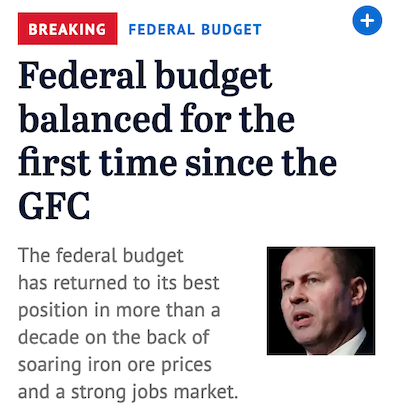
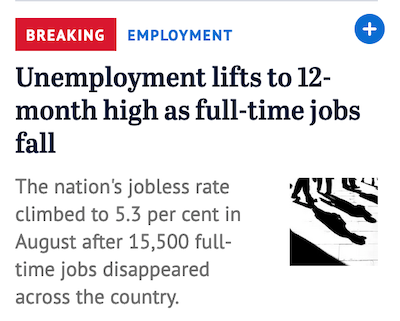
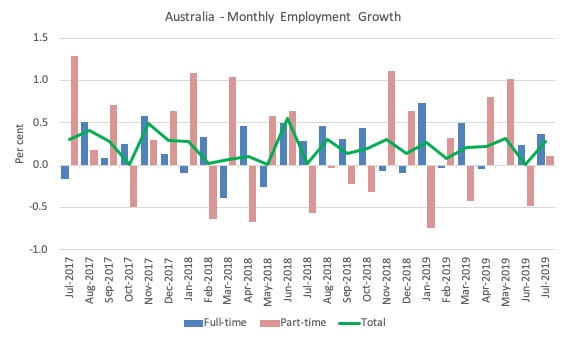
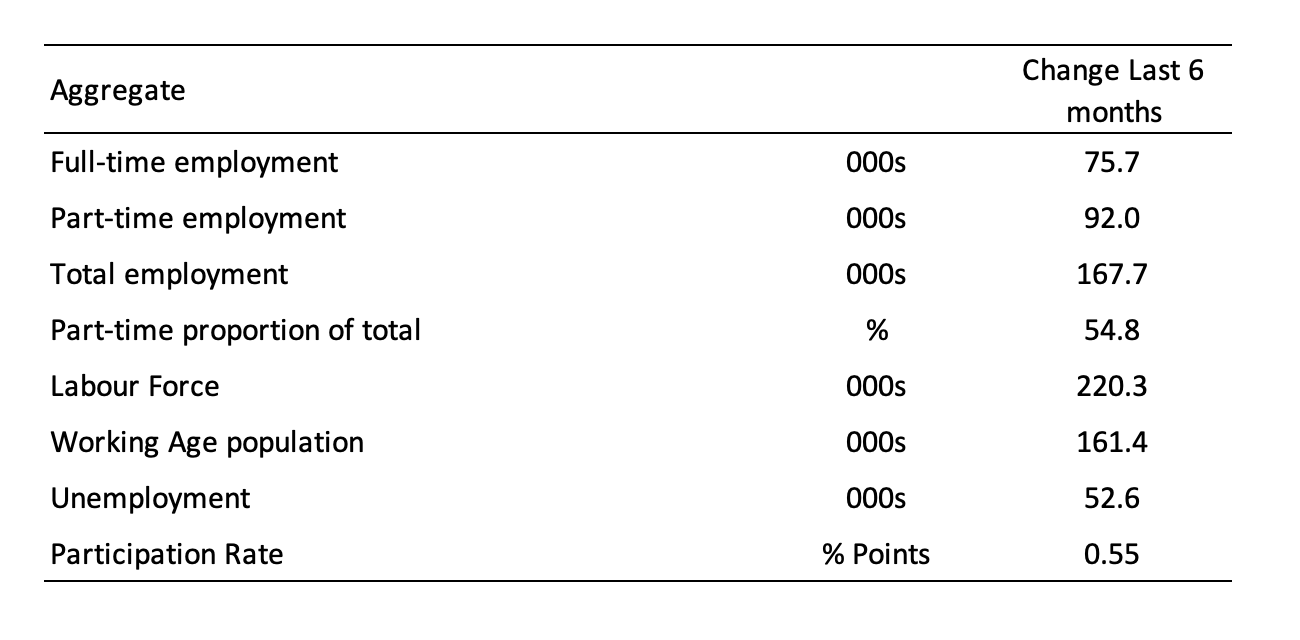
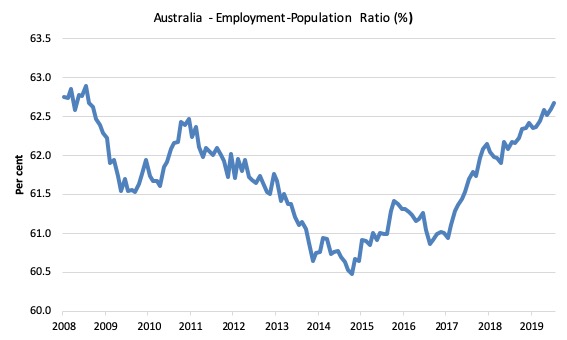
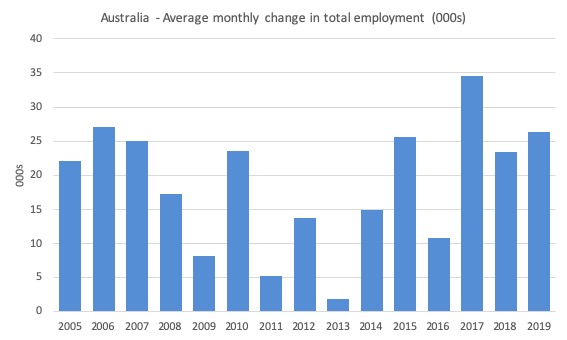
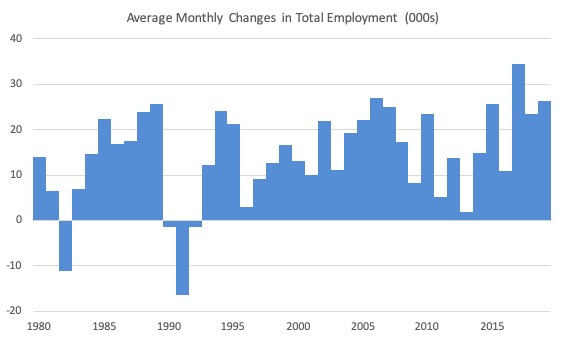
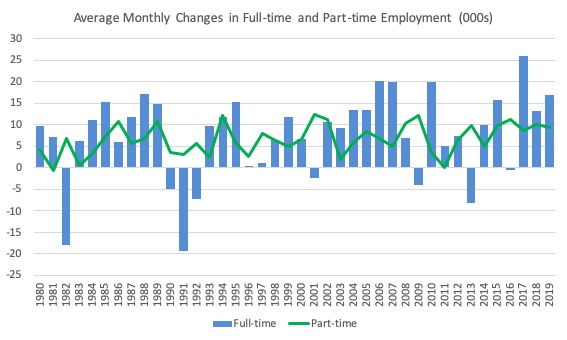
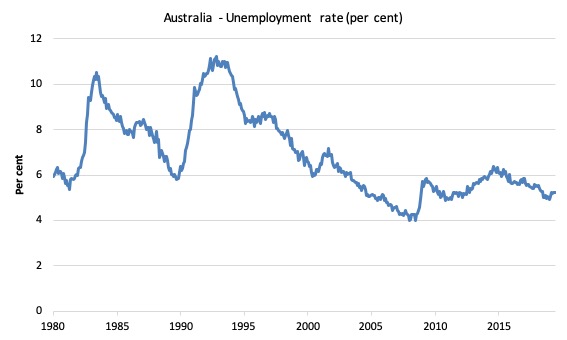
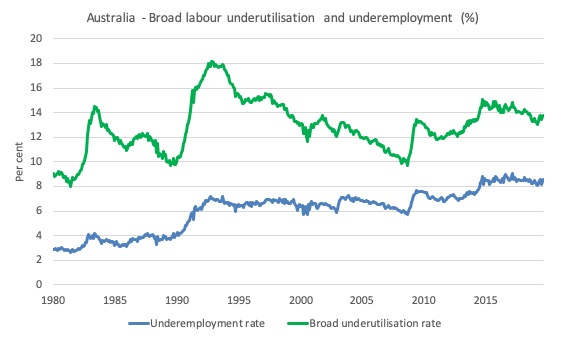
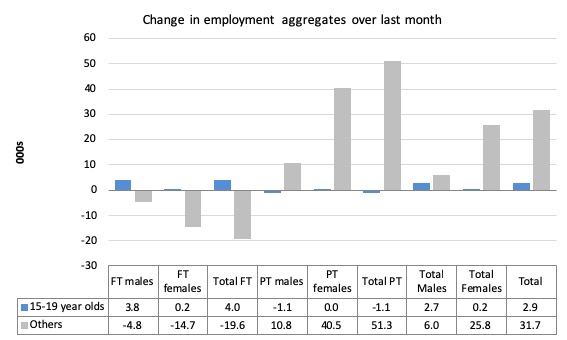
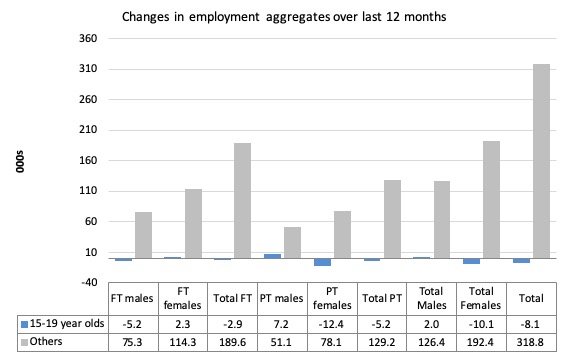
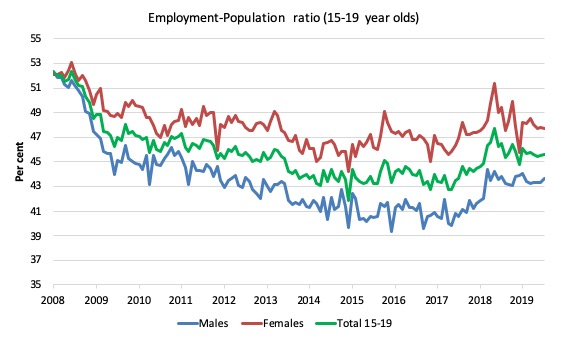
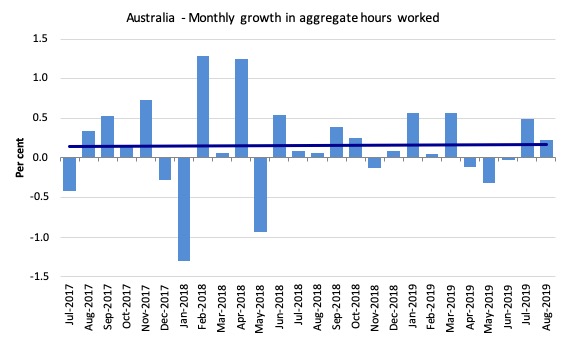
The headlines are pretty ironic.
It is quite sad that fully grown men and women can’t go beyond looking at the government budgetary balance.
@Tom – we’ve been so indoctrinated for so very long to believe that returning budget surpluses is the exemplar of good governance that we associate good economic times with budget surpluses (Australia under the Howard government during the long, massive household debt boom and massive mining investment boom) but don’t associate the budget moving toward balance with poor economic outcomes.
In my opinion, MMT’s problem has always been that it is describing fundamental facts………that run completely contrary to what our daily lived experience tells us. That’s been the hard part. Academic and professional people around the world are beginning to embrace MMT but whether such counter-intuitive facts can be understood and accepted by the public at large any time soon remains to be seen. Eventually it will come though.
Prospector; Not necessarily the daily ‘lived’ experience, but the daily ‘pissing on our back and say it’s raining’ experience.
The trend is clear. Increasing casualisation of the labour force and growing levels of underemployment.
Yes, prospector i agree.
But its just sad man.
millions of years of evolution and still can’t get pass some numbers.
This persistent labour wastage is an ongoing scandal across the developed nations. Its social and political consequences are corrosive.
We need to get it through to the electorate that fiscal deficits must occur in the face of the propensity to save by households and businesses in the private sector in order to sustain aggregate demand and minimize un-and-underemployment, particularly in nations with a trade deficit.
Another thing about unemployment and underemployment is that it allows employers to work their workers to inhuman levels: after all, you don’t want to be fired and join the army of unemployed.
It gives tremendous power to capital to do “speeding up” (the jungle).
I see my friends and family member haves worked themselves so they become ill due to stress.
@Matt B – agree that we are being pissed on and told the opposite.
It’s just that that which is factually incorrect appears to the average person to be the most basic, commonsense truth because it’s natural to observe our own personal experiences and then extrapolate that up and apply it broadly.
Our lived experience through our senses is tells us that the Earth is flat – how could it possibly be any other shape?
Our lived experience through our senses tells us that the Earth is fixed at the centre of the universe and that the sun goes around us – again, so very obviously true according to what we experience yet so completely wrong. Copernicus was lucky to have survived standing up and saying “hey guys, I think it’s actually US that’s going around the sun.”
The most basic premises that MMT reveals as being completely false – ie, taxes pay for sovereign government spending, the government functions just like a big household or business and all the rest of that rubbish – continue to make basic common sense to the average person on the street.
MMT is beginning to sweep through Academia but for the public at large whom have little to no interest in how economies function, the Earth is still a flat plain that sits fixed at the centre of the universe, so to speak. The false premises that the dominant neoliberal paradigm are built on closely accord with how John and Jane Average see and experience the world, which acts to continually reinforce them in the public’s mind.
That’s the harder bit – not so much getting people to accept new ideas but convincing them to let go of old ones that form the very basis of everything they understand to be “true.”
@Leftwinghillbillyprospector,
All very good points.
I give you 3 thumbs-up.
We don’t give each other here enough thumbs.